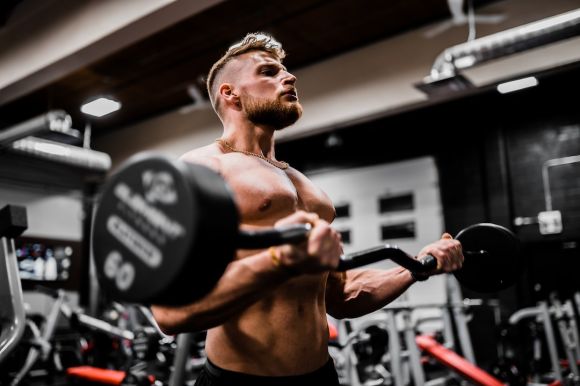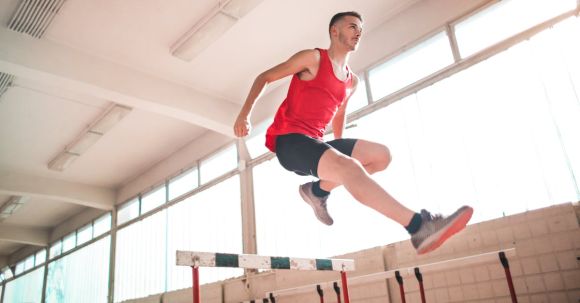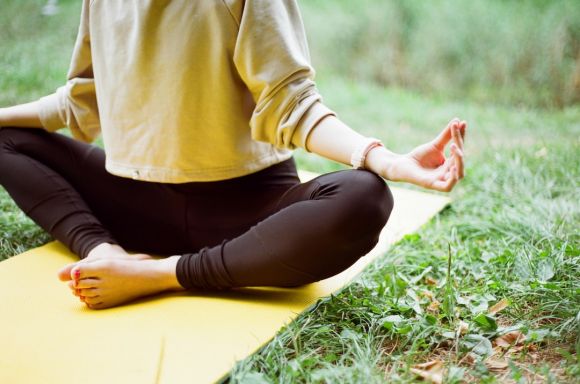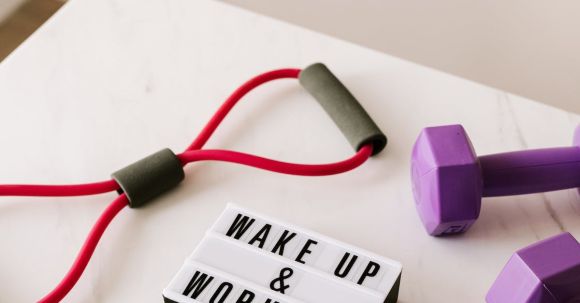Yoga has become increasingly popular in recent years, and for good reason. Not only does it offer a multitude of mental and physical benefits, but it also provides a holistic approach to wellness. One of the key advantages of practicing yoga is its ability to improve flexibility and strength. Whether you are a beginner or an experienced yogi, incorporating yoga into your fitness routine can help you achieve a more balanced and flexible body.
Author: fit-on
In the world of sports, athletes are constantly seeking ways to improve their skills and performance. While regular training and practice are essential, incorporating sports-specific workouts can take your game to the next level. These workouts target the specific muscles and movements required for your sport, helping you develop the strength, speed, and agility necessary to excel. Whether you're a basketball player, a soccer enthusiast, or a swimmer, here are some sports-specific workouts to enhance your skills.
Basketball: Jump Higher, Move Quicker
Basketball is a fast-paced game that demands explosive power and agility. To improve your skills on the court, focus on workouts that develop your jumping ability and quickness. Incorporate exercises like box jumps, squat jumps, and plyometric lunges to build lower body strength and explosiveness. Additionally, agility ladder drills and cone drills can help improve your footwork and coordination, enabling you to move quicker and change directions efficiently.Soccer: Build Endurance, Enhance Agility
Soccer players require a combination of endurance, agility, and coordination. To enhance your performance on the field, include workouts that focus on building cardiovascular endurance and agility. High-intensity interval training (HIIT) exercises like shuttle runs and sprints can help improve your stamina and speed. Incorporate ladder drills and cone dribbling exercises to enhance your footwork and agility. Additionally, strength training exercises like squats, lunges, and planks can help build the necessary strength and stability.Swimming: Increase Power, Improve Technique
Swimming is a highly technical sport that requires a unique combination of strength and technique. To improve your swimming skills, consider incorporating workouts that focus on increasing power and improving technique. Resistance training exercises such as band pulls and medicine ball throws can help build upper body strength and power. Additionally, drills that focus on body position, stroke technique, and breathing can help refine your swimming form and efficiency in the water.Tennis: Improve Speed, Strengthen Core
Tennis is a sport that demands quick movements, agility, and a strong core. To enhance your game on the court, include workouts that focus on improving speed and strengthening your core. Interval training exercises like shuttle runs and lateral shuffles can help improve your speed and agility. Incorporate core exercises such as planks, Russian twists, and medicine ball rotations to build a strong and stable core, which is essential for generating power and maintaining balance during your swings.Golf: Increase Flexibility, Enhance Stability
Golf requires a combination of flexibility, stability, and precision. To improve your skills on the course, incorporate workouts that focus on increasing flexibility and enhancing stability. Stretching exercises like trunk rotations, shoulder stretches, and hip stretches can help improve your range of motion and flexibility. Additionally, balance exercises such as single-leg stands and stability ball exercises can help enhance your stability and coordination, leading to more consistent and controlled swings.Conclusion: Elevate Your Performance
Sports-specific workouts are designed to target the specific muscles and movements required for your sport, helping you take your skills to new heights. By incorporating these workouts into your training routine, you can enhance your strength, speed, agility, and overall performance. Remember to always prioritize proper form and technique, listen to your body, and gradually progress in intensity and difficulty. With consistent effort and dedication, you can elevate your performance and achieve your goals in your chosen sport.
In today's fast-paced world, finding time to hit the gym can be challenging. Between work, family, and other commitments, it's easy to neglect our fitness goals. However, with the right mindset and a few simple tools, you can boost your cardio and stay in shape without leaving the comfort of your home. By incorporating home workouts into your routine, you can save time, money, and still achieve your fitness objectives.
Benefits of Home Workouts
1. Convenience: One of the biggest advantages of home workouts is the convenience they offer. No more rushing to the gym during peak hours or waiting in line for equipment. With home workouts, you have the freedom to exercise whenever it suits you, without any time constraints. 2. Cost-effective: Gym memberships can be expensive, especially if you don't utilize them regularly. By investing in a few essential pieces of workout equipment, such as dumbbells or resistance bands, you can create a home gym that caters to your cardio needs at a fraction of the cost. 3. Privacy: Some people feel self-conscious working out in front of others. With home workouts, you have the privacy to exercise without worrying about judgment or feeling uncomfortable. This can help you focus on your fitness goals and push yourself to new limits. 4. Variety: Home workouts offer endless opportunities for variety. From high-intensity interval training (HIIT) to dance workouts or yoga, you can find a wide range of online resources and videos to keep your cardio routine exciting and engaging. Experiment with different workouts to find what suits you best.Effective Home Cardio Workouts
1. Jump rope: A simple and effective way to get your heart rate up is by jumping rope. It's a full-body workout that improves cardiovascular endurance and burns calories. Start with short intervals and gradually increase your time as your fitness level improves. 2. High-intensity interval training (HIIT): HIIT workouts involve short bursts of intense exercise followed by brief recovery periods. This type of training has been shown to improve cardiovascular health and burn fat more efficiently. Look for HIIT workouts online or create your own by alternating between exercises like jumping jacks, burpees, and mountain climbers. 3. Circuit training: Circuit training combines strength and cardio exercises in a fast-paced manner. Set up a circuit of exercises that target different muscle groups and perform them one after another with minimal rest in between. This type of workout keeps your heart rate elevated while building strength and endurance. 4. Dance workouts: Dancing is a fun and effective way to get your heart pumping. Choose a dance style that you enjoy, whether it's Zumba, hip hop, or salsa, and follow along with online tutorials. Not only will you improve your cardiovascular fitness, but you'll also boost your mood and reduce stress.Stay Motivated
1. Set goals: Define your fitness goals and create a plan to achieve them. Whether it's improving your endurance, losing weight, or increasing your stamina, having specific objectives will help you stay focused and motivated. 2. Track your progress: Keep a workout journal or use a fitness app to track your progress. Seeing how far you've come can be incredibly motivating and help you stay on track. 3. Find a workout buddy: Partnering up with a friend or family member can make home workouts more enjoyable. You can hold each other accountable, share workout ideas, and motivate each other to reach your fitness goals. 4. Mix it up: Don't be afraid to try new workouts or vary your routine. Keeping things fresh and exciting will prevent boredom and keep you motivated to continue your home workouts. In conclusion, home workouts offer a convenient, cost-effective, and versatile way to boost your cardio fitness. With a variety of exercises and resources available, you can create a home gym that caters to your needs and helps you achieve your fitness goals. Stay motivated, set goals, and enjoy the freedom and privacy that home workouts provide. Start today and see the difference it can make in your cardiovascular health.
When it comes to fitness goals, everyone has their own preferences and desires. Some people strive to build lean, sculpted muscles, while others simply want to gain strength without adding bulk. If you fall into the latter category, you may be wondering how to achieve this balance. In this article, we will explore the best strategies to get stronger without getting bulky.
Focus on Compound Exercises
Compound exercises are movements that engage multiple muscle groups at the same time. These exercises are highly effective for building strength without adding excessive muscle mass. By incorporating compound movements into your workout routine, you can target a wide range of muscles while maximizing your strength gains. Some examples of compound exercises include squats, deadlifts, bench presses, and pull-ups. These exercises recruit several muscle groups, allowing you to build functional strength without excessive hypertrophy. Aim to include compound exercises in your workout routine two to three times per week.Lift Heavy, but with Fewer Repetitions
To get stronger without getting bulky, it is important to lift heavy weights. However, instead of performing high repetitions, focus on lower rep ranges with heavier weights. This approach stimulates the nervous system and promotes strength gains without significant muscle growth. Aim for three to five sets of three to six repetitions with a weight that challenges you. This intensity will help you build strength and improve your overall performance without adding bulk.Prioritize Progressive Overload
Progressive overload is a key principle in strength training. It involves gradually increasing the demands placed on your muscles over time. By consistently challenging your muscles with heavier weights or more repetitions, you stimulate further strength adaptations. To apply progressive overload, start with a weight that allows you to perform the desired number of repetitions with good form. As you become stronger, gradually increase the weight or the number of repetitions. This gradual progression will help you get stronger without packing on excess muscle mass.Incorporate Plyometrics and Explosive Movements
Plyometric exercises and explosive movements are excellent additions to any strength training routine. These exercises involve rapid and powerful muscle contractions, which improve muscular power and speed without significant hypertrophy. Exercises such as box jumps, medicine ball throws, and kettlebell swings are great options for incorporating plyometrics and explosive movements into your workouts. These exercises engage your fast-twitch muscle fibers, which are responsible for explosive movements and overall strength.Implement High-Intensity Interval Training (HIIT)
High-Intensity Interval Training (HIIT) is a training method that alternates between short bursts of intense exercise and brief recovery periods. HIIT workouts are efficient and effective for improving cardiovascular fitness and building strength without excessive muscle growth. By combining strength exercises with cardiovascular intervals, you can create a HIIT workout that targets both strength and endurance. This approach helps you develop lean muscle while burning calories and improving your cardiovascular health.Conclusion: Striking the Right Balance
Achieving strength gains without adding bulk is possible with the right approach. By focusing on compound exercises, lifting heavy weights with fewer repetitions, prioritizing progressive overload, incorporating plyometrics and explosive movements, and implementing HIIT workouts, you can get stronger without getting bulky. Remember to listen to your body, challenge yourself, and stay consistent with your training regimen. With dedication and the right strategies, you can achieve your strength goals while maintaining a lean and toned physique.
In the world of sports, athletes constantly strive to improve their performance and gain a competitive edge. One surefire way to achieve this is through sports-specific training. This type of training focuses on the specific movements, skills, and demands of a particular sport, enabling athletes to enhance their performance and reach their full potential. Whether you are a professional athlete or a weekend warrior, incorporating sports-specific training into your routine can make a significant difference in your performance.
Understanding the Importance of Sports-specific Training
Sports-specific training involves tailoring your workouts to mimic the movements and demands of your chosen sport. By doing so, you can improve your strength, speed, agility, and overall performance in a way that directly translates to your sport. This type of training recognizes that each sport requires unique physical attributes and skills, and aims to develop those specific areas.Designing a Sports-specific Training Program
To maximize the benefits of sports-specific training, it is crucial to design a program that aligns with the demands of your sport. Start by analyzing the movements, skills, and physical qualities required in your sport. For example, if you are a basketball player, you may need to focus on vertical jumping, lateral quickness, and hand-eye coordination. Once you have identified the key elements, you can incorporate exercises and drills that target those areas.Enhancing Strength and Power
Strength and power are critical components of most sports. In sports-specific training, you can incorporate exercises that improve your strength and power in a sport-specific manner. For example, a tennis player may include exercises that strengthen the muscles used in their swing, such as weighted racket swings or medicine ball rotations. By training these muscles in a sport-specific way, you can enhance your ability to generate power and perform at a higher level.Improving Speed and Agility
Speed and agility are crucial in sports that require quick bursts of movement and rapid changes in direction. Sports-specific training can help you improve your speed and agility by focusing on exercises that mimic the movements and demands of your sport. For instance, a soccer player may incorporate ladder drills and cone drills to improve their footwork and reaction time. By practicing these specific movements, you can enhance your speed, agility, and overall performance on the field.Developing Sport-specific Skills
In addition to physical attributes, sports-specific training also aims to improve sport-specific skills. For example, a golfer may incorporate drills that focus on their swing technique or putting accuracy. By practicing these skills in a targeted and deliberate manner, you can improve your technique, consistency, and overall performance in your sport.Incorporating Mental Training
Sports-specific training goes beyond physical conditioning; it also includes mental training. Mental strength and focus are vital in achieving peak performance. By incorporating mental training techniques, such as visualization, positive self-talk, and goal setting, you can enhance your mental resilience and improve your performance under pressure.Maximizing Your Performance
To maximize your performance with sports-specific training, consistency is key. Incorporate these training methods into your routine regularly, and track your progress to ensure you are continuously challenging yourself and making improvements. Additionally, consider seeking guidance from a qualified coach or trainer who can provide personalized guidance and tailor your training program to your specific needs.Conclusion: Unleash Your Full Potential
Sports-specific training is a game-changer when it comes to enhancing performance in sports. By tailoring your workouts to mimic the movements and demands of your sport, you can improve your strength, speed, agility, and sport-specific skills. Incorporating mental training techniques further enhances your performance and helps you reach your full potential. So, unleash your full potential by incorporating sports-specific training into your routine and watch your performance soar to new heights.
In our fast-paced world, it’s easy to get caught up in the hustle and bustle of daily life. With work, family, and social commitments, finding time for exercise can be a challenge. However, it’s important to remember that rest and recovery are just as crucial as the actual workout itself. In fact, incorporating adequate rest and recovery into your fitness routine can have numerous benefits for both your physical and mental well-being.
The Science Behind Rest and Recovery
To understand the importance of rest and recovery, it’s essential to delve into the science behind it. During exercise, our muscles undergo stress and strain. This results in tiny tears in the muscle fibers. While this might sound alarming, it’s actually a normal part of the muscle-building process. It is during the recovery phase that our bodies repair and rebuild these muscle fibers, making them stronger and more resilient. Without adequate rest, our muscles do not have the opportunity to repair and grow. This can lead to overtraining, which can have serious consequences for our overall health. Overtraining can result in decreased performance, increased risk of injury, and even mental health issues such as depression and anxiety.The Benefits of Rest and Recovery
1. Enhanced Performance: Rest and recovery are essential for optimal performance. When we allow our bodies to rest, we give our muscles a chance to repair and grow, ultimately leading to improved strength and endurance. 2. Injury Prevention: Rest days are crucial for injury prevention. Continuous training without rest can put excessive stress on our joints and muscles, increasing the risk of overuse injuries such as tendonitis or stress fractures. 3. Mental Well-being: Exercise has been shown to have numerous mental health benefits, such as reducing stress and improving mood. However, it’s important to strike a balance between exercise and rest. Overtraining can actually have the opposite effect, leading to increased stress and decreased mental well-being. 4. Improved Sleep: Regular exercise has been linked to improved sleep quality. However, it’s important to note that intense exercise too close to bedtime can actually disrupt sleep. Incorporating rest days into your routine can help ensure that you get the restful sleep that your body needs for optimal recovery. 5. Long-term Sustainability: Incorporating rest and recovery into your fitness routine is essential for long-term sustainability. By allowing your body the time it needs to rest and repair, you decrease the risk of burnout and increase the likelihood of sticking to your fitness goals in the long run.How to Incorporate Rest and Recovery into Your Routine
Now that we’ve established the importance of rest and recovery, you might be wondering how to incorporate it into your own fitness routine. Here are a few tips to get you started: 1. Schedule Rest Days: Just as you schedule your workouts, make sure to schedule rest days as well. Aim for at least one or two rest days per week, where you focus on gentle activities such as stretching or yoga. 2. Listen to Your Body: Pay attention to how your body feels. If you’re feeling excessively fatigued or sore, it may be a sign that you need to take a day off. 3. Incorporate Active Recovery: On your rest days, consider incorporating gentle activities such as walking, swimming, or cycling. This can help promote blood flow to your muscles, aiding in the recovery process.Conclusion
In conclusion, rest and recovery are essential components of any fitness routine. By allowing our bodies the time they need to rest and repair, we can enhance performance, prevent injuries, and improve our overall well-being. So, next time you’re tempted to skip a rest day, remember that rest is just as important as the actual workout. Give yourself permission to rest and recover, and watch as your fitness journey becomes more sustainable and enjoyable.
In today's fast-paced world, it's no surprise that anxiety and stress levels are on the rise. We often find ourselves overwhelmed with work, personal responsibilities, and the constant demands of technology. However, by incorporating guided relaxation techniques into our daily routines, we can take control of our mental well-being and reduce anxiety and stress.
Understanding Anxiety and Stress
Before we dive into the various guided relaxation techniques, let's first understand what anxiety and stress are. Anxiety is a feeling of unease, such as worry or fear, that can be mild or severe. On the other hand, stress is the body's response to a demand or threat, which can be both physical and emotional. While some level of anxiety and stress is normal, chronic or excessive levels can have detrimental effects on our health.The Power of Guided Relaxation
Guided relaxation is a technique that involves using auditory or visual cues to induce a state of relaxation. By focusing our attention on these cues, we can redirect our thoughts from anxious or stressful stimuli to more calming and soothing ones. This helps activate the body's relaxation response, reducing the levels of stress hormones and promoting a sense of calmness.Deep Breathing: A Simple Technique with Powerful Effects
One of the most accessible and effective guided relaxation techniques is deep breathing. By taking slow, deep breaths and focusing on the sensation of inhaling and exhaling, we can activate the body's relaxation response and reduce anxiety and stress. To practice deep breathing, find a quiet place, sit or lie down comfortably, and close your eyes. Inhale deeply through your nose for a count of four, hold for a count of four, and exhale slowly through your mouth for a count of four. Repeat this cycle for several minutes, allowing your body to relax with each breath.Progressive Muscle Relaxation: Unwinding the Tension
Another helpful guided relaxation technique is progressive muscle relaxation. This technique involves systematically tensing and then relaxing different muscle groups in the body. By doing so, we can release physical tension and promote a sense of relaxation. To practice progressive muscle relaxation, start by tensing the muscles in your toes and then slowly work your way up to your head, tensing and relaxing each muscle group as you go. Pay attention to the sensations of tension and relaxation, allowing yourself to let go of any physical stress.Visualization: Creating a Calm Mental Oasis
Visualization is a guided relaxation technique that involves creating mental images of calming and peaceful scenes. By immersing ourselves in these visualizations, we can transport our minds to a tranquil space and reduce anxiety and stress. To practice visualization, find a quiet and comfortable space, close your eyes, and imagine yourself in your ideal peaceful setting. It could be a beach, a forest, or any place that brings you a sense of calmness. Engage all your senses in the visualization, focusing on the sights, sounds, smells, and textures of your imagined environment.Incorporating Guided Relaxation into Daily Life
To truly benefit from guided relaxation techniques, it's important to incorporate them into our daily lives. Carve out a few minutes each day to practice deep breathing, progressive muscle relaxation, or visualization. You can also explore guided meditation apps or videos that provide step-by-step instructions for relaxation exercises. Additionally, try to create a peaceful environment by eliminating distractions and finding a quiet space where you can focus on your relaxation practice.In Conclusion: Taking Control of Your Mental Well-being
By incorporating guided relaxation techniques into our daily routines, we can take control of our mental well-being and reduce anxiety and stress. Whether it's through deep breathing, progressive muscle relaxation, or visualization, these techniques offer a simple yet powerful way to promote relaxation and calmness in our lives. Remember to make time for yourself and prioritize your mental health – you deserve it.Creating Your Own Meditation Space at Home
In today's fast-paced world, finding moments of peace and tranquility is more important than ever. One way to achieve this is by creating your own meditation space at home. Having a dedicated area where you can relax, unwind, and connect with your inner self can greatly enhance your meditation practice. Here are some steps to help you create a serene and inviting meditation space in the comfort of your own home.Choose the Right Location
The first step in creating your own meditation space is to choose the right location. Look for a quiet and secluded area in your home where you can escape from distractions. It could be a spare bedroom, a corner of your living room, or even a small nook in your backyard. The key is to find a space that feels calm and inviting to you.Declutter and Cleanse the Space
Once you have chosen the location, the next step is to declutter and cleanse the space. Remove any unnecessary items or clutter that may distract you during your meditation practice. Clean the area thoroughly to create a fresh and inviting atmosphere. This will help you create a clean canvas for your meditation space.Set the Mood with Lighting
Lighting plays a crucial role in creating the right ambiance for your meditation space. Natural light is ideal, as it creates a sense of openness and tranquility. If natural light is not available, opt for soft, warm lighting that is easy on the eyes. Consider using candles, fairy lights, or Himalayan salt lamps to add a soothing glow to your meditation space.Choose Comfortable Seating
Comfort is key when it comes to meditation. Choose a seating option that allows you to sit comfortably for an extended period of time. This could be a meditation cushion, a yoga mat, or a comfortable chair. Experiment with different seating options to find what works best for you and your body.Add Personal Touches
Personalize your meditation space by adding meaningful and calming elements. This could be a small altar with items that hold spiritual significance to you, such as crystals, statues, or photographs. Incorporate elements from nature, such as plants or seashells, to bring a sense of grounding and serenity to your space. Consider hanging inspirational quotes or artwork that resonates with you.Create a Sound Sanctuary
Sound can greatly enhance your meditation experience. Consider incorporating soothing sounds into your meditation space. This could be through the use of a meditation app, a small fountain, or a singing bowl. Experiment with different sounds and find what helps you relax and focus during your meditation practice.Establish a Routine
To make the most of your meditation space, establish a regular meditation routine. Set aside dedicated time each day to sit in your meditation space and practice mindfulness. Consistency is key when it comes to reaping the benefits of meditation. By establishing a routine, you will create a sense of ritual and make your meditation space an integral part of your daily life. In conclusion, creating your own meditation space at home can provide you with a sanctuary of peace and tranquility in the midst of a busy world. By carefully choosing the location, decluttering and cleansing the space, setting the right mood with lighting, and personalizing it with meaningful elements, you can create a space that supports your meditation practice. Remember to prioritize comfort, incorporate soothing sounds, and establish a regular routine to fully immerse yourself in the benefits of meditation. So go ahead, carve out a little corner of your home and create your own oasis of calmness and serenity.
Are you tired of struggling with weight loss? Do you want to feel confident and comfortable in your own skin? Look no further! Fit on Weight Loss Programs are here to help you discover a new you. With personalized plans, expert guidance, and a supportive community, you'll be on your way to achieving your weight loss goals in no time.
Customized Plans for Success
One size does not fit all when it comes to weight loss. That's why Fit on offers personalized plans tailored to your individual needs and goals. Whether you're looking to shed a few pounds or make a significant lifestyle change, our programs are designed to help you succeed. Our team of experts will work with you to create a plan that fits your schedule, preferences, and dietary restrictions. Say goodbye to cookie-cutter diets and hello to a plan that works for you.Expert Guidance Every Step of the Way
Embarking on a weight loss journey can be overwhelming, but with Fit on, you're never alone. Our team of experienced professionals is here to guide you every step of the way. From nutritionists and personal trainers to psychologists and wellness coaches, we have the experts you need to help you reach your goals. No matter what challenges or obstacles you may face, we'll be there to offer support, advice, and motivation. With Fit on, you'll have all the tools you need to succeed.A Supportive Community
Weight loss is not just about shedding pounds; it's also about finding a supportive community that understands your journey. At Fit on, we pride ourselves on fostering a welcoming and inclusive environment for all. Our online community is a place where you can connect with others who are on the same path as you. Share your successes, ask for advice, and find inspiration from those who have already achieved their goals. With Fit on, you'll never feel alone on your weight loss journey.A Holistic Approach to Wellness
Weight loss is about more than just numbers on a scale. It's about creating a healthy and balanced lifestyle that you can maintain in the long run. That's why Fit on takes a holistic approach to wellness. Our programs focus not only on nutrition and exercise but also on mental and emotional well-being. We believe that true transformation comes from addressing all aspects of your life. With Fit on, you'll not only lose weight but also gain a newfound sense of confidence, self-love, and overall well-being.Embrace the New You
As you embark on your weight loss journey with Fit on, remember to embrace the new you. Celebrate your progress, no matter how small, and be proud of yourself for taking the first step towards a healthier and happier life. Weight loss is not just about physical changes; it's about transforming into the best version of yourself. With Fit on, you have the power to discover a new you and live your life to the fullest. In conclusion, Fit on Weight Loss Programs offer a personalized and holistic approach to help you achieve your weight loss goals. With customized plans, expert guidance, a supportive community, and a focus on overall wellness, you'll be well on your way to discovering a new you. Embrace the journey, believe in yourself, and let Fit on be your partner in achieving the body and life you've always dreamed of. Start your transformation today!
Strength training is a great way to improve your overall fitness and build strength and muscle. However, if you're new to strength training, it can be a bit overwhelming. With all the different exercises and techniques, where do you even start? Don't worry, we've got you covered. Here are 5 essential strength training tips for beginners to help you get started on your fitness journey.









